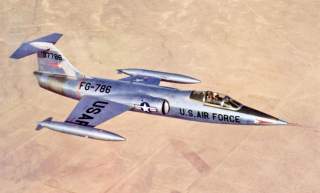A Quick Look at Why the F-104 Starfighter Was the Best Interceptor of Its Time
An amazing weapon of war.
Designed as a supersonic superiority fighter, the F-104 Starfighter was lightning-fast. Development of the F-104 began in 1952, and the first XF-104 made its initial flight in 1954.
As YF-104A testing continued into 1956, the first USAF contract was placed on Mar. 2, for 146 F-104As and six F-104Bs for Air Defence Command (ADC), with 56 externally similar F-104Cs for Tactical Air Command (TAC). As explained by Peter E Davies in his book F-104 Starfighter Units in Combat, a further 21 F-104Cs were added on Dec. 26. Lockheed’s hot new fighter entered ADC service with the 83rd Fighter Interceptor Squadron (FIS) at Hamilton AFB, California, on Jan. 26, 1958, two years after the anticipated introduction date.
Its sister squadron, the 84th FIS, traded in its ‘gravel gobbler’ Northrop F-89J Scorpions in June 1959 to become the first ADC unit with the two-seat F-101B Voodoo. Seventeen squadrons eventually re-equipped with this big McDonnell fighter, which was ADC’s principal all-weather interceptor for four years.
While the F-104A’s gun and two Sidewinders were effective at short range, the F-101B could carry two AIR-2A Genie nuclear-tipped missiles with a range of more than six miles, or up to six AIM-4 Falcon infrared missiles. F-104As were inevitably short-term occupants of the interceptor alert ‘pads’ because they could not accommodate the electronic equipment required to integrate fully into America’s complex SAGE (semi-automatic ground environment) defence network.
For ADC, the fighter’s spectacular climb and speed performance figures were compelling at a time when the US was thought to be well behind the USSR in the size of its bomber forces. This was an illusion dispelled in 1961 by another Lockheed product in the form of the U-2, which conducted flights that revealed much smaller Soviet air forces and no evidence of the `nuclear powered bomber’ that was believed to exist in 1958.
By then, however, ADC had ordered the long-delayed Convair F-102A Delta Dagger followed by developed version of the aircraft the F-106A Delta Dart. With a more powerful search radar and Genie missile armament, this was ADC’s intended interceptor, but it too was delayed, with production aircraft unavailable until May 1959. ADC therefore decided to use the F-104A (and a two-seat conversion of the F-101 Voodoo) as an interim interceptor rather than as an a superiority fighter, since its performance was clearly far superior to the existing F-102A and old types.
Some concerns were expressed by senior figures like Brig Gen Stanley Holtoner, who criticized the aircraft’s short interception range using only internal fuel. He estimated that this was only 150 miles against a target at 45,000 ft, but much less for those at higher altitude. In fact, although the F-101, F-102 and F-106 had better subsonic interception radii, the F-104 was the only fighter that could make a Mach 1.5 (or better) interception up to a distance of 150 miles with wingtip Sidewinders. Its interception times from being scrambled were superior to those of the F-106A, and it could perform interceptions at a greater range than any comparable fighter. The myth of the F-104’s lack of range may have originated in the tendency of senior officers and politicians to seek fuel-exhausting Mach 2 back-seat rides in the two-seat F-104B, which only carried 73 per cent of the fuel load of the single-seat aircraft.
However, within ADC, the 83rd FIS’s primary task was to meet and destroy high-altitude intruders. Training involved sorties against SAC bombers and even Lockheed U-2 reconnaissance aircraft. The Starfighter excelled in this role, and although F-104As were confined to four squadrons, including the 83rd FIS, their first, short period of ADC service was eventful. Tom Delashaw famously intercepted a U-2 at 72,000 ft and performed a roll around the spyplane to show its pilot that he was not the only inhabitant of those lofty heights. He also zoom-climbed an F-104 to 92,000 ft over West Germany while on a deployment during the Berlin Crisis — his way of demonstrating that any Soviet high-flyerswere also vulnerable to the Starfighter.
Service entry of 83rd FIS F-104As was an ideal opportunity to demonstrate the aircraft’s performance and enhance its reputation at a time when accidents during the fighter’s test programme were still making unwelcome headlines. Maj Harold C Johnson from the Hamilton unit reached 91,249 ft over Edwards AFB, California, on May 7, 1958, while Capt Walter W Irwin attained 1404.9 mph over a 15-mile (25 km) course at the same location on May 16. The F-104A thus became the first aircraft to hold both the World Airspeed and World Altitude records simultaneously. Further time-to-climb records were set on Dec. 10 and 13 and on the 14th Capt Joe Jordan flew an F-104C to 103,389 ft, beating the existing high-altitude balloon record and making the F-104 the first aircraft to exceed 100,000 ft entirely under its own power.
This article by Dario Leone originally appeared on The Aviation Geek Club in 2019.
Image: Wikimedia

